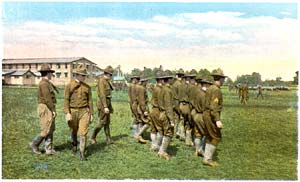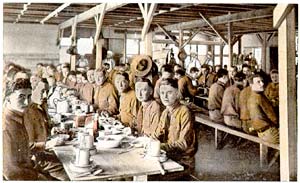Robert Blumenstein grew up in Elgin and got a job as a car inspector for the railroad. By March 1917, his younger brother, David, had already left his post office job to join the Army. He was stationed at the Vancouver Barracks and soon sent letters back to the family. Perhaps one of these letters inspired Robert to enlist six months later. He could help his country win the war and see the world at the same time if he joined the Navy.
A Very Different Place
Blumenstein's naval career started at the bottom as an apprentice seaman. The Navy wasted no time in sending him to the Naval Training Station at San Francisco. More specifically, he was stationed at Goat Island, now known as Yerba Buena Island, in the San Francisco Bay. The scenic vista from the station was striking to a young man from a small eastern Oregon town:
"On nights when there is no fog the view from there [a hill on the island] is great. Frisco is about two miles across the bay to the west and Oakland about the same distance to the east of the island. Both cities are lit up by thousands of electric lights and large ferries are continually crossing the bay. In the daytime you can see ships coming in and others leaving, bound for all parts of the world. There are a couple of warships lyeing [sic] at anchor in the Frisco harber [sic] now, I think one of them is the old Oregon [USS Oregon battleship that served as flagship of the Pacific Fleet]."
Blumenstein's appreciation of his station waned on foggy days, however. It was so thick at times and so difficult to see that it reminded him of winter snow storms in Elgin. When the fog would roll in off the ocean "two blankets hardly keep one warm enough."
Vaccinations Come Early
By World War I, vaccinations were becoming more routine for those serving in the military. Certainly, the risks of death from disease rivaled those related directly to combat and military planners were keen to cut losses wherever they could. As a result, Blumenstein and many others endured a series of vaccinations, often including smallpox and typhoid.
Because the use of vaccines on such a large scale was relatively new and still inexact, negative reactions were not uncommon and deaths sometimes followed. Blumenstein described his experiences:
Guard Duty
Blumenstein had to stand guard duty periodically. The radio station on the top of the hill required particular attention since it was, he believed, the largest wireless station on the West Coast. It was a key naval communications asset and had to be protected. Four guards would watch over the radio station during the day but 16 drew duty at night, slowly walking within sight of each other and allowing only those with passes near the radio station.
Heads Up
 Army recruits train during World War I. Soldiers, sailors, and marines all drilled long hours. (Image, freepages.military.rootsweb.com)
Army recruits train during World War I. Soldiers, sailors, and marines all drilled long hours. (Image, freepages.military.rootsweb.com)
Blumenstein and his company spent much of their days drilling and in spite of the sense of bewilderment that came with learning new drills, he was satisfied they were "pretty good and have the cleanest company up here." Of course, Blumenstein had an incentive to stay focused: "If any of the men don't pay attention to orders when we are having battalion drill they are made to ride their guns behind the band like kids used to ride stick horses." Blumenstein managed to avoid the fate but several others each day would "ride their guns."
Life After Drilling
The seemingly constant drilling led to very healthy appetites. While the food may not have been remarkable, often consisting of potatoes, meat, and eggs, the quantities consumed reminded Blumenstein of what a ravenous saw mill crew would eat. Still, with all of the food, he craved more sweets such as fruit and jellies. That problem was solved by eating candy purchased at the canteen. Yet money was strictly limited. The sailors could not draw all of their pay until they completed training. In the meantime, they had just been issued their first pay of two dollars each.
 Soldiers sit down to eat in a camp mess hall. No branch of the service was known for the exceptional quality of its food, but at least there was a lot of it. (Image, freepages.military.rootsweb.com)
Soldiers sit down to eat in a camp mess hall. No branch of the service was known for the exceptional quality of its food, but at least there was a lot of it. (Image, freepages.military.rootsweb.com)
Without much money to spend and infrequent shore leave, the men spent much of their free time reading and writing letters to family and friends. While the Navy experience was an adventure, homesickness still played a part for many who had never left their homes before enlisting: "Seems like mail time is the best part of the day when everyone is looking for letters from home." And, with limited drills on the weekends, writing became a very popular activity: "It is hard to find a pen and ink to write with on Sat and Sun as everyone is spending his spare time writing."
Steering the Ship
After he completed training in November, Blumenstein went on to successful service in the Navy. He was promoted to seaman second class and three months later became a seaman serving on the USS Dorothea that operated in the West Indies during the war. The ship patrolled in Mexican waters and along the southern coast of the U.S. until 1918. In December 1917 Blumenstein gained promotion to coxswain. His duty, among other tasks, involved steering the ship. Soon after, the Dorothea sailed from New Orleans for Havana, Cuba, where it was used for the remainder of the war to train Cuban naval officers. Months after the signing of the Armistice, Blumenstein was discharged at Puget Sound Washington, thus ending his wartime career.
Notes
(Oregon State Defense Council Records, Personal Military Service Records, World War I, Box 6, Union County, School District No. 23)